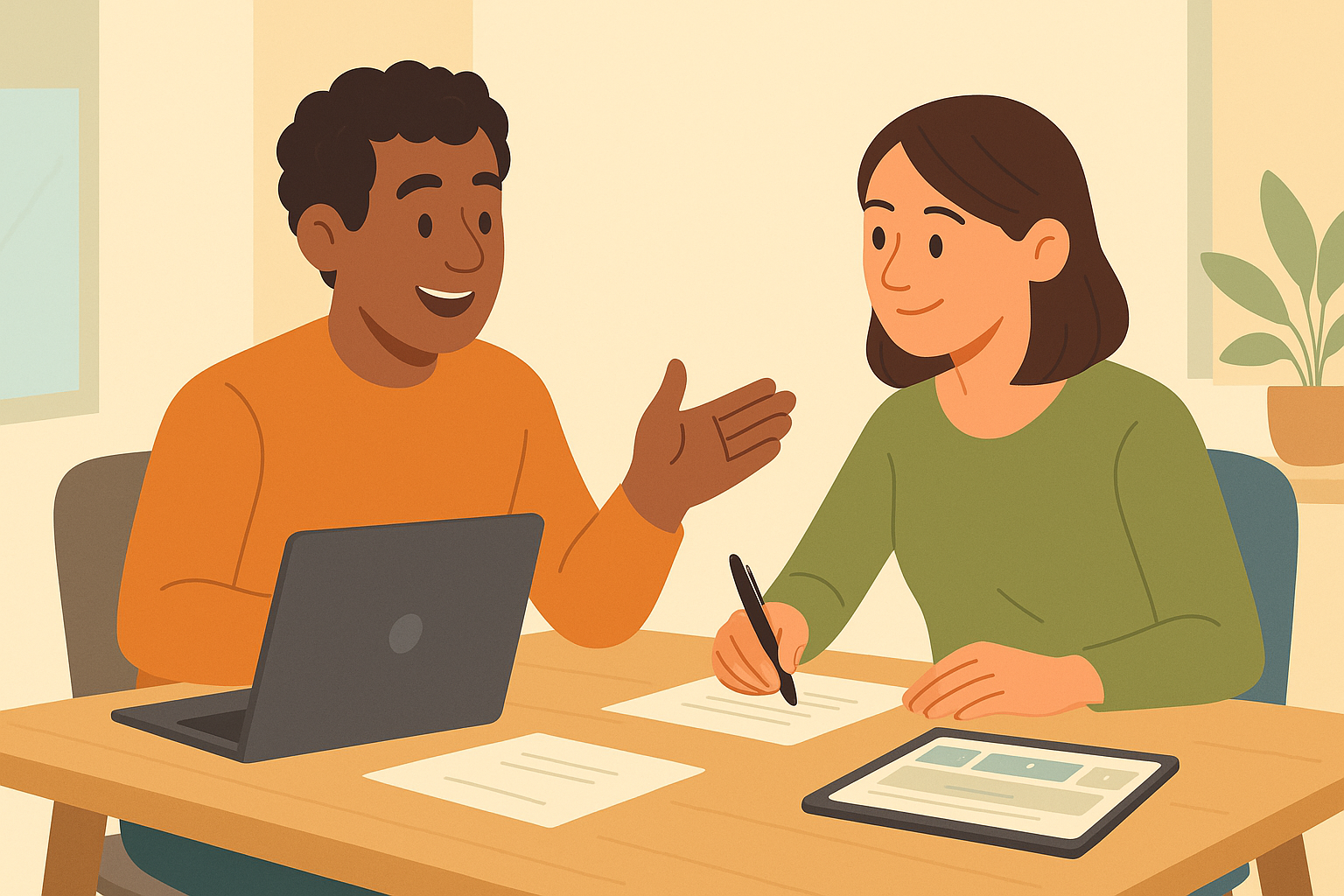How to extract knowledge from subject matter experts (without annoying them)
Subject matter experts are brilliant at what they do. That’s why you need them to create your course.
But here’s the problem: being an expert doesn’t make someone a teacher. The dentist who can perform a flawless root canal might struggle to explain it clearly. The compliance officer who knows every regulation inside out might not know where to start when building a training course.
This is the subject matter expert challenge. They have the knowledge you need, but extracting it, structuring it, and turning it into effective learning experiences requires skill, patience, and a process that respects their time and expertise.
Over seven years developing courses with dentists, compliance officers, teachers, and food safety professionals, I’ve worked with over 100 subject matter experts to create hundreds of courses. Some collaborations were smooth. Others were painful. The difference almost always came down to process, not personality.
Here’s what I’ve learned about working with SMEs to create courses that actually work, without driving anyone mad in the process.
The SME challenge: Experts aren’t teachers
The fundamental challenge when working with subject matter experts is that expertise and teaching ability are completely different skills.
Experts think differently. They’ve internalised their knowledge to the point where what seems obvious to them is completely opaque to beginners. They skip steps because those steps are automatic for them. They use jargon without realising it’s jargon. They assume context that learners don’t have.
This is called the curse of knowledge. The better you know something, the harder it becomes to remember what it’s like not to know it.
Experts often want to teach everything. When you ask an expert about a topic, they want to give you the complete picture. Every nuance. Every exception. Every edge case. This is admirable, but it’s not always helpful. Learners need focused, progressive content, not encyclopaedic brain dumps.
Experts are busy. They’re experts because they’re good at their jobs, which means they’re in demand. They don’t have unlimited time to sit in meetings explaining concepts. You need to extract maximum value from minimum time.
Many experts aren’t natural writers. Some can articulate concepts brilliantly on paper. Many can’t. They know their subject inside out but struggle to write clear, structured explanations. This isn’t a criticism – writing for learners is a specific skill that most people don’t have.
And now there’s a new challenge: AI-generated content. Some SMEs are using AI tools to write course content rather than writing it themselves. The output looks professional but often lacks the nuance, practical context, and real-world examples that make expert content valuable. It can be generic, missing the judgment calls and experience-based insights that only a real expert can provide.
Your job as a learning designer isn’t to be the expert. It’s to be the bridge between the expert’s knowledge and the learner’s needs.
Preparation: What to ask before meetings
The worst way to work with an SME is to schedule a meeting and say “tell me about compliance.” You’ll get a rambling brain dump that’s hard to structure and full of irrelevant detail.
The best collaborations start with preparation. Before you ever sit down with an SME, you need clarity on what you’re building.
Define the learning objectives first
Before the SME gets involved, answer these questions:
- Who is this course for? (Their job role, experience level, context)
- What do they need to be able to DO after completing it? (Not “understand,” but actually do)
- What’s the scope? (What’s in, what’s out)
- How will success be measured? (Assessment, practical application, compliance requirement)
Share this with the SME before your first meeting. This frames the conversation and prevents the expert from trying to cover everything.
Send a briefing document
A simple one-page brief sets expectations:
- Course title and purpose
- Target audience
- Learning objectives (3-5 maximum)
- Estimated course length
- Key topics to cover
- What you need from them (content review, scenarios, examples, assessment questions)
- Timeline and deadlines
This shows you’ve done your homework and respect their time.
Do your own research first
Don’t go into meetings knowing nothing about the topic. Read existing materials. Watch videos. Understand the basics. This lets you ask better questions and focus SME time on what only they can provide: nuance, real-world context, practical application, and judgment calls.
Example from experience:
When developing compliance courses, I never went into meetings cold. Often I’d be accompanied by another team member who had relevant experience. I’d read the regulations first, identified what confused me, and came prepared with specific questions: “The guidance says X, but how does this actually work in a busy practice?” This focused conversations on practical application rather than basic information I could have read myself.
Facilitation techniques: Getting the good stuff
Once you’re in the room (or on the call) with an SME, your job is facilitator, not note-taker.
Ask specific questions, not open-ended ones
Bad question: “Tell me about infection control.” Good question: “Walk me through what happens when a patient arrives. What’s the first thing staff need to check?”
Specific questions ground experts in concrete scenarios rather than abstract concepts. They also reveal workflow, sequence, and decision points that learners need to understand.
Use scenarios to extract judgment
Experts make dozens of judgment calls daily without thinking about them. Your job is to surface those decisions and explain them.
“Imagine a new staff member asks you: ‘Can I use this equipment for this procedure?’ How do you decide?”
Scenarios force experts to articulate their reasoning, which is often more valuable than facts learners can look up.
Challenge assumptions (respectfully)
When an expert says “everyone knows this,” push back gently: “I didn’t know that until you told me. Can we explain it for learners who might not?”
When they skip steps: “You said do X, then Z. What happened to Y? Is there a step in between?”
This isn’t about catching them out. It’s about filling gaps that learners will encounter.
Record everything (with permission)
Don’t rely on notes. Record meetings (with consent) so you can focus on the conversation rather than frantically scribbling. You’ll catch nuances, phrasing, and examples you’d miss otherwise.
Example from experience:
When developing fire safety courses, I found that asking “What’s the most common mistake you see?” surfaced real-world scenarios that regulations alone didn’t cover. These became the most valuable parts of courses because they addressed what actually goes wrong, not just what the rules say.
Template-based approaches: Making it easier for everyone
Templates are your secret weapon when working with SMEs. They provide structure, reduce ambiguity, and make collaboration faster.
Content templates
Rather than asking SMEs to “write content,” give them a template:
Lesson template:
- Topic name
- Learning objective (what will learners be able to do?)
- Key concepts (3-5 bullet points)
- Real-world example or scenario
- Common mistakes or misconceptions
- Practical application (how learners use this)
This framework helps experts organise their knowledge in ways that work for learning, not just for reference.
Scenario templates
For case studies or scenarios:
- Context (who, what, where)
- The situation or problem
- What options exist
- What the correct approach is and why
- What happens if you get it wrong
Assessment question templates
For quiz questions:
- Question text
- Correct answer
- Why it’s correct
- Common wrong answers
- Why they’re wrong
This ensures assessments test understanding, not just recall.
Example from experience:
Providing templates transformed SME collaboration in my experience. Instead of getting rambling documents that had to be restructured, I got focused content that fit directly into courses. SMEs appreciated the clarity too—they knew exactly what was needed and didn’t waste time guessing.
Iteration and feedback: The secret to great courses
First drafts are always rough. That’s fine. Your job is to turn expert knowledge into learner-friendly content through iteration.
Build, review, refine
After your first meeting, create a rough draft of the lesson or module. Don’t wait for perfection. Get something down that the SME can react to.
“Here’s what I understood from our conversation. Have I got this right? What’s missing? What’s wrong?”
This is far more productive than “tell me more” meetings. Concrete drafts give experts something to correct, which is easier than creating from scratch.
Focus SME time on what matters
Don’t ask SMEs to proofread grammar or check formatting. Ask them to verify:
- Technical accuracy
- Practical applicability
- Completeness (have we missed anything critical?)
- Real-world relevance (does this actually work in practice?)
Test with real learners, then refine
Once you have a draft SMEs are happy with, test it with actual learners (or people similar to your target audience). Their confusion reveals gaps the SME might not spot.
“Learners are getting stuck on this section. Can we simplify the explanation or add an example?”
SMEs are usually happy to help when they see real learner feedback, not just your opinion.
Example from experience:
In my experience, developing a course module and sending it to the SME for review, then soft-launching to a small group of learners, worked well. Feedback from that group (combined with quiz performance data) showed where explanations weren’t clear. I could then go back to the SME with specific questions: “Learners are struggling with concept X. Can we break this down differently?”
This data-driven iteration produced much better courses than trying to get everything perfect before launch.
Common SME challenges and how to handle them
Challenge 1: “I don’t have time for this”
Solution: Respect their time ruthlessly. Short, focused meetings. Clear agendas. Templates that make their input easy. Record meetings so they don’t need to repeat themselves.
Show them you’ve done your homework and you’re only asking for what they uniquely can provide.
Challenge 2: “This is too simple / you’re dumbing it down”
Solution: Remind them of the audience and objectives. “Our learners aren’t experts yet. They need to walk before they run. We can add advanced content later, but first they need the foundations.”
Experts sometimes resist simplification because they think it undermines their expertise. Frame it as “making your knowledge accessible” rather than “dumbing down.”
Challenge 3: “You’ve got this wrong”
Solution: Listen. They’re probably right. Ask clarifying questions: “Help me understand what I’ve missed. Can you explain it differently?”
Never get defensive. You’re not the expert—they are. Your job is translation, not technical accuracy.
Challenge 4: “I want to add everything from this 200-page document”
Solution: Scope control. “That’s valuable information, but it’s beyond what learners need for this course. Could we create supplementary materials for people who want to go deeper?”
Help SMEs distinguish between “need to know” and “nice to know.”
Challenge 5: “I don’t know how to explain this, I just do it”
Solution: Observe them actually doing the task, if possible. Or ask them to walk through a specific example step by step. Sometimes experts can’t articulate process in the abstract, but they can describe specific instances.
Challenge 6: The slow responder
Solution: Some SMEs are slow and require constant chasing. If you find yourself babysitting an SME, sometimes it’s best to be firm. Deadlines exist for a reason. If they consistently miss deadlines despite reminders, it may be time to cut them loose or simply not work with them again. Your time is valuable too, and a project can’t be held hostage by one person’s inability to meet commitments.
What makes SME collaboration work
After working with over 100 SMEs across multiple industries, the successful collaborations shared common traits:
Clear expectations from the start.Both sides knew what was needed, when, and in what format.
Respect for expertise.I never positioned myself as the expert or challenged their technical knowledge. My expertise was in learning design, not their field.
Treating them like professionals.This means clear communication, respecting their time, and acknowledging their contributions. But it also means something more fundamental: paying them on time. This is essential. Nothing damages trust faster than late payments or chasing invoices. Pay SMEs promptly and they’ll be happy to work with you again. Make them chase payment and you’ve burned a bridge.
Structured processes.Templates, agendas, and frameworks made collaboration efficient and reduced ambiguity.
Iteration, not perfection.Building rough drafts quickly and refining them through feedback rather than trying to get everything perfect on the first attempt.
Data to guide decisions.When disagreements arose about content or approach, learner feedback and performance data resolved them better than opinions.
Appreciation and credit.SMEs were acknowledged in courses. Their contributions were valued publicly. This isn’t just nice—it’s essential for ongoing collaboration.
The relationship matters as much as the process
Process is important, but relationships matter more. The best courses I’ve created came from genuine partnerships with SMEs who trusted me to translate their expertise into effective learning.
That trust came from:
- Demonstrating I’d done my homework
- Respecting their time
- Listening more than talking
- Being willing to revise when I got things wrong
- Showing them that learners valued their expertise
- Paying them on time, every time
When SMEs see that their knowledge is genuinely helping people, they become invested. They go from “I have to do this” to “I want to make this great.”
Some of my best professional relationships came from course development projects. Years later, I’m still in touch with SMEs I worked with on early courses. They refer colleagues to me. They’re happy to collaborate on new projects.
This doesn’t happen by accident. It happens when you treat experts as partners, not content vending machines.
Final thoughts
Working with subject matter experts is one of the most challenging and rewarding parts of learning design.
You’re asking busy, brilliant people to articulate knowledge they’ve spent years accumulating. You’re translating expert thinking into beginner-friendly content. You’re managing expectations, timelines, and often strong opinions about what should be included.
Get it wrong, and you’ll frustrate experts, waste time, and produce mediocre courses.
Get it right, and you’ll create learning experiences that genuinely help people while building relationships with experts who become long-term collaborators.
The key isn’t magical facilitation skills or perfect templates (though both help). It’s respect, preparation, clear structure, and a genuine partnership mindset.
Experts have the knowledge. You have the learning design expertise. Together, you can create something neither could build alone.
That’s when the magic happens.
About the author: I’ve spent seven years building and managing e-learning platforms, developing hundreds of courses in collaboration with over 100 subject matter experts across dentistry, education, food safety, and compliance sectors. I specialise in translating expert knowledge into effective, learner-friendly courses while maintaining strong collaborative relationships with SMEs.







